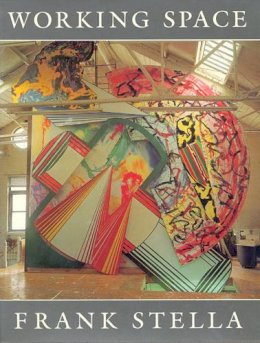
Working Space
Frank Stella
Working Space affords a rare opportunity to view painting from the inside out, through the eyes of one of the world’s most prominent abstract painters. Frank Stella describes his perception of other artists’ work, as well as his own, in this handsomely illustrated volume.
Stella uses the crisis of representational art in sixteenth-century Italy to illuminate the crisis of abstraction in our time. The artists who followed Leonardo, Michelangelo, Raphael, and Titian searched for new directions to advance their work from beneath the shadow of these great painters. Caravaggio pointed the way. So today, Stella believes, the successors to Picasso, Kandinsky, and Pollock must seek a pictorial space as potent as the one Caravaggio developed at the beginning of the seventeenth century. Stella sees Caravaggio as the pivot on whom painting turns, his consummate illusionism prompting the advance of a more flexible, more “real” space that allows painting to move and breathe, to suggest extension and unrestricted motion. Following Caravaggio, Rubens’ broad vision of fullness and active volume gave painting a momentum that helped propel it into the nineteenth century, where it came to rest in the genius of Géricault and Manet, themselves the precursors of modern painting.
Unfortunately, both contemporary abstract art and figurative painting have become trapped by ambiguous pictorial space and by a misguided emphasis on materiality (pigment for pigment’s sake). Pictorial qualities have given way to illustrational techniques. Abstract art has become verbal, defensive, and critical, caught up in theology masquerading as theory. Stella asserts that painting must understand its past, make use of the lucid realism of seventeenth-century Italy, and absorb a Mediterranean physicality to reinforce the lean spirituality of northern abstraction pioneered by Mondrian and Malevich. Working Space will provoke discussion and argument, not least because Stella offers nontraditional evaluations of the works of giants such as Raphael, Titian, Michelangelo, Picasso, and Pollock, as well as lesser-known figures including Annibale Carracci, Paulus Potter, and Morris Louis. The artist’s powers of discernment and the profusion of his ideas and opinions will dazzle and engage professionals, amateurs, and students of art.
Product Details
About Frank Stella
Reviews for Working Space
Peter Schjeldahl
New York Times Book Review
Working Space comes as something of a bombshell. For this is a book that explodes a great many received ideas about abstraction… [It] is certainly one of the most remarkable books ever written on the subject. What makes it so remarkable, of course, is that Stella is unquestionably the most celebrated abstract painter of his generation.
Hilton Kramer
The Atlantic
It is seldom that a major artist is prepared to commit himself publicly to a considered, large-scale survey of the art of his time, and to relate it moreover to substantial cross-sections of the art of the past. Frank Stella has done this in his Charles Eliot Norton Lectures at Harvard, with considerable erudition, great verve and genuine originality.
John Golding
Times Literary Supplement
This is a marvelously insightful and thought-provoking book… Stella’s perception of the problem is correct—abstraction has reached a watershed. His analysis of that problem is erudite and plausible, and at times even passionate. If he does not solve it within these pages, he at least has made us consider its ramifications, and he has enabled us to look at art from a valuable and rarely available perspective.
Edward J. Sozanski
Philadelphia Inquirer
Working Space develops its thesis with such gusto, elegance, and conviction… The text is rich with insight, integrity, and unexpected rethinkings of erstwhile familiar images.
David Anfam
Art International
This is art history and art criticism of a high order, detailed and refreshingly idiosyncratic. Both scholarly and hip, Stella has written a book that reveals the painter’s mind and studio, allowing us to see the play of history and vision that goes on within. Highly recommended.
Calvin Reid
Library Journal
